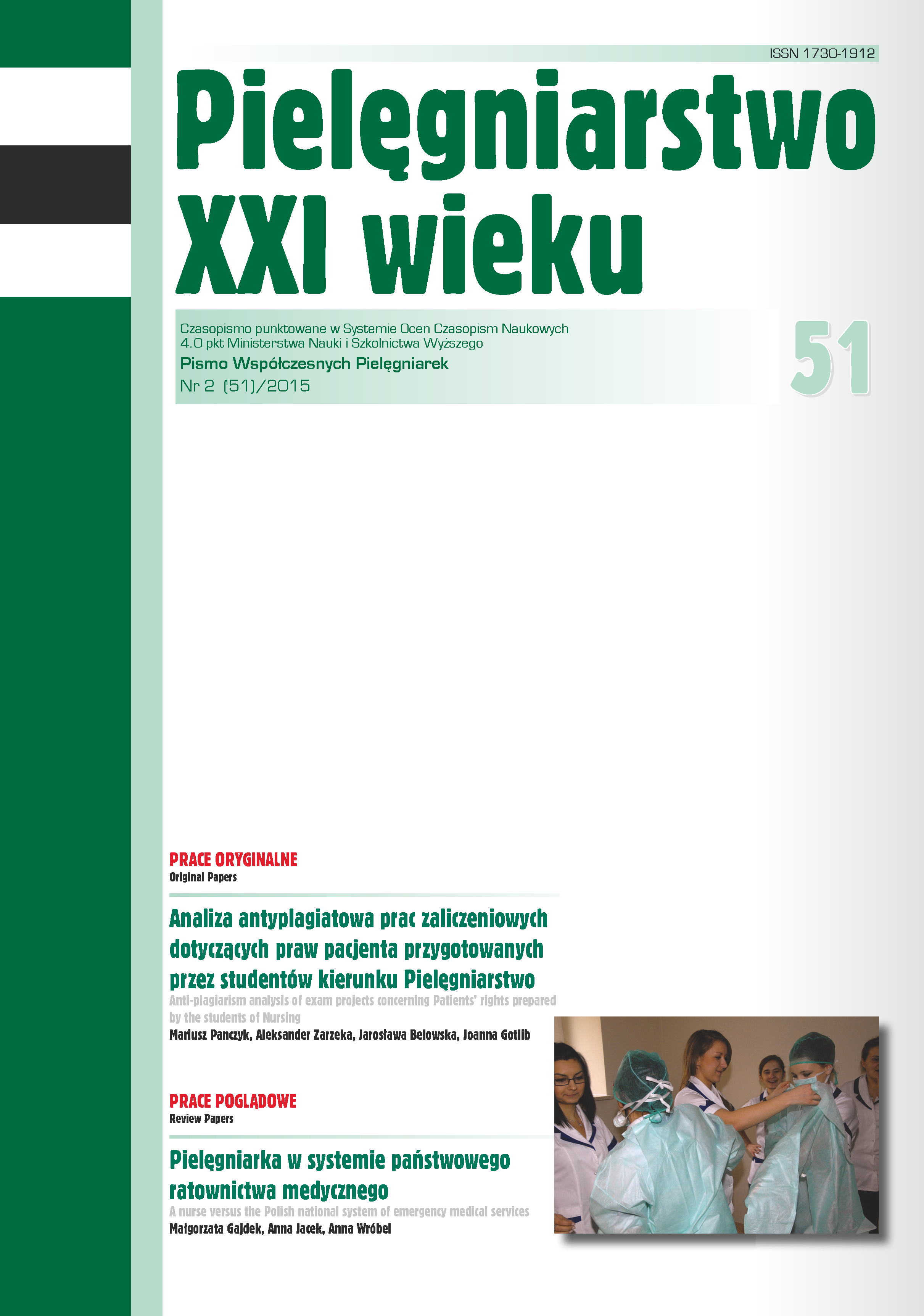Anti-plagiarism analysis of exam projects concerning Patients’ rights prepared by the students of Nursing
DOI:
https://doi.org/10.12923/p21w-2015-2/16Keywords:
plagiarism, nursing education research, postgraduate nursing educationAbstract
ANTI-PLAGIARISM ANALYSIS OF EXAM PROJECTS CONCERNING PATIENTS’ RIGHTS PREPARED BY THE STUDENTS OF NURSING
Aim. A comparative analysis of essays, prepared as exam projects looking at the concept of “Patients’ rights” written by the full-time students (ST group) and part-time students (NST group) of the Nursing Masters program at the Medical University of Warsaw (MUW). The aim was to detect any plagiarism.
Material and methods. The study has been conducted by looking at written works submitted by two groups of students (n = 178): 111 ST group (n = 111) and NST group (n = 67). In the study, the anti-plagiarism system called Turnitin® was used, which allowed to generate three parameters: the general one (OWP), internet one (IWP) and cross-parameter one (KWP) of the similarity factor. Both the Levene’s test of variance homogeneity and U Mann Whitney non-parametric test were used.
Results. The OWP level reached 20%, which means that a text could be suspected of having been plagiarised if the rate equalled 52% of all the studied exam projects (OWP average ≈ 32%). The OWP average for ST and NST was 29.9 vs. 35.9% respectively. Differentiation level of all similarity parameters was similar in both groups (Levene’s test P > 0.05). Moreover, IWP level was statistically higher than in NST group, as opposed to ST group (U Mann-Whitney test, P < 0.04). Regarding the KWP parameter, there were no relevant differences between the two groups of students (U Mann-Whitney test, P > 0.05).
Conclusions. Identified indicators of unauthorised borrowings observed in NST group mean that students require education in the area of “Copyrights”. Generally high values of similarity parameters in both groups justify the necessity of introducing a more rigorous anti-plagiarism control of all texts, independently prepared by students.
References
1. Ercegovac Z, Richardson JV. Academic dishonesty, plagiarism included, in the digital age: A literature review. Coll Res Libr. 2004;65 (4): 301-18.
2. Ellery K. Undergraduate plagiarism: a pedagogical perspective. Assess Eval High Educ. 2008;33 (5): 507-16.
3. Selwyn N. ‘Not necessarily a bad thing…’: a study of online plagiarism amongst undergraduate students. Assess Eval High Educ. 2008;33 (5): 465-79.
4. Kiehl EM. Using an ethical decision-making model to determine consequences for student plagiarism. J Nurs Educ. 2006;45 (6): 199-203.
5. Park C. Rebels without a clause: towards an institutional framework for dealing with plagiarism by students. J Futh High Educ. 2004;28 (3): 291-306.
6. Uchwała Senatu Uniwersytetu Jagiellońskiego. Akademicki Kodeks Wartości. 2003.
7. Perfect TJ, Field I, Jones R. Source credibility and idea improvement have independent effects on unconscious plagiarism errors in recall and generate-new tasks. J Exp Psychol Learn Mem Cogn. 2009;35 (1): 267.
8. Barta J, Markiewicz R. Autorskoprawne problemy prac magisterskich i doktorskich. [w:] Wosik E, red. Raport o zasadach poszanowania autorstwa w pracach dyplomowych oraz doktorskich w instytucjach akademickich i naukowych. Warszawa: Fundacja Rektorów Polskich; 2005:7-17.
9. Lyon C, Barrett R, Malcolm J. Plagiarism is easy, but also easy to detect: Ann Arbor, MI: Scholarly Publishing Office, University of Michigan Library; 2006.
10. Ustawa z dnia 11 lipca 2014 r. o zmianie ustawy – Prawo o szkolnictwie wyższym oraz niektórych innych ustaw (Dz.U. 2014 poz. 1198).
11. McCabe DL. Academic dishonesty in nursing schools: an empirical investigation. J Nurs Educ. 2009;48 (11): 614-23.
12. http://turnitin.com/pl/features/originalitycheck, dostęp 4 styczeń 2015.
13. Park EJ, Park S, Jang IS. Academic cheating among nursing students. Nurse Educ Today. 2013;33 (4): 346-52.
14. Culwin F. An active introduction to academic misconduct and the measured demographics of misconduct. Assess Eval High Educ. 2006;31 (2): 167-82.
15. Youmans RJ. Does the adoption of plagiarism-detection software in higher education reduce plagiarism? Stud High Educ. 2011;36 (7): 749-61.
16. Dahl S. Turnitin®: The student perspective on using plagiarism detection software. Act Lear High Edu. 2007;8 (2): 173-91.
17. McCabe DL, Trevino LK. Individual and contextual influences on academic dishonesty: A multicampus investigation. Res High Educ. 1997;38 (3): 379-96.
18. McCabe DL, Trevino LK, Butterfield KD. Cheating in Academic Institutions: A Decade of Research. Ethics Behav. 2001;11 (3): 219-32.
19. Wideman MA. Caring, sharing, coping and control: Academic dishonesty and the nursing student: University of Toronto; 2009.
20. Kirkland KD. Academic honesty: Is what students believe different from what they do? : Bowling Green State University; 2009.
21. Harper MG. High tech cheating. Nurse Educ Pract. 2006;6 (6): 364-71.
22. Tippitt MP, Ard N, Kline JR, et al. Creating environments that foster academic integrity. Nurs Educ Perspect. 2009;30 (4): 239-44.
23. Ha B. Wissenschaft der Forschung und Kommunikation und die Ausbildung der Studiumsethik. Ratio et Oratio. 2009;2 (1): 7-33.
24. Brown VJ, Howell ME. The efficacy of policy statements on plagiarism: do they change students’ views? Res High Educ. 2001;42 (1): 103-18.
25. Bennett R. Factors associated with student plagiarism in a post-1992 university. Assess Eval High Educ. 2005;30 (2): 137-62.
Downloads
Published
Issue
Section
License
Copyright (c) 2024 Mariusz Panczyk, Aleksander Zarzeka, Jarosława Belowska, Joanna Gotlib (Autor)

This work is licensed under a Creative Commons Attribution 4.0 International License.




